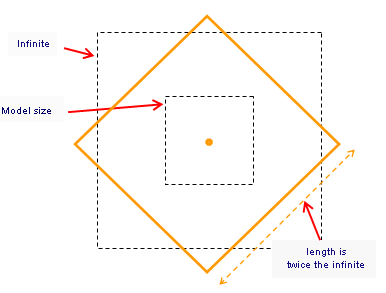
Geometric Modeler |
Geometry |
About the Model Size and InfiniteThe parameters driving the model validity in terms of dimensions |
| Technical Article | ||
AbstractModels must conform to validity criteria related to their size. Two parameters drive the model validity in terms of dimensions: the model size and the "infinite". These two parameters are explained below. |
Here are the values of the model size and infinite:
| Until CATIA V5 R13 | From CATIA V5 R14 | |
| Model Size |
[-100 meters, + 100 meters] on each coordinate |
[-1000 meters, + 1000 meters] on each coordinate |
| Model infinite (10 x model size) |
[-1000 meters, + 1000 meters] on each coordinate |
[-10000 meters, + 10000 meters] on each coordinate |
The validity of geometric objects depend on their location within the limits defined by the model size and infinite. The validity rules are explained below.
[Top]
Rule 1
Except authorized infinite objects (see rule 2), any relimited objects should be included in the model size. Objects that are not included in the model size are called « infinite ».
The authorized infinite objects the
user can create are: the planes, lines, half-lines and points. The
visualization of such objects is always reframed at most to the model size. The
parts of the infinite object that are not in the model size are not seen by the
user.
Should an infinite object necessarily fit in the "infinite"?
No. An infinite object does not necessarily exactly fit in the model infinite. Usually, its larger coordinates are between half and twice the model infinite.
When a plane is not « parallel » to canonical planes, it is usually not possible to relimit it exactly in the model infinite. When such an infinite plane is created, its half-dimension with the model infinite is determined. Thus a part of it is in the infinite, while a part of it is outside the infinite.
Note: at creation, infinite lines fit in the model infinite.
Are transformations of infinite objects valid?
Transformation of
infinite objects are valid provided their origins remain within the model size.
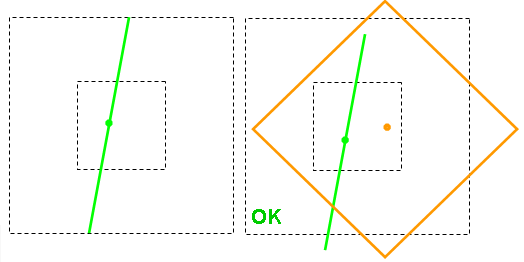
Rule 3
The mathematical definition of an object should be in the model infinite.
An example: the circle arc
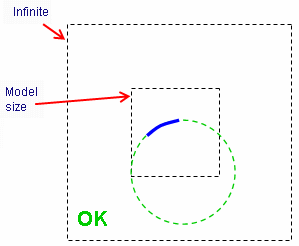
The mathematical definition of the circle consists of a radius which must be smaller than the infinite and a center which must be in the infinite.
On the left-hand side figure, the created arc circle (in blue) is in the model size, the mathematical circle (in dashed green) is in the infinite (rule 4). This model is valid.
The figures below are examples of unauthorized geometries. On the first
figure, the model itself (the full circle in blue) sticks out from the model
size.
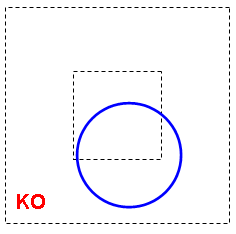 On the second figure, the model (the circle arc in blue) is in the model
size but the mathematical definition does not fit in the inifinite.
On the second figure, the model (the circle arc in blue) is in the model
size but the mathematical definition does not fit in the inifinite.
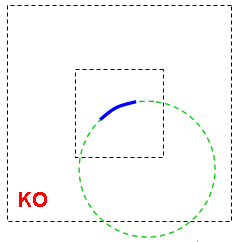
The origin of planes and lines should be in the model size.
An example: the infinite line
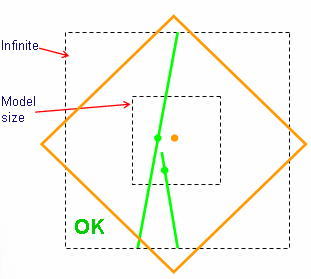
On the left-hand side figure, the infinite line and semi infinite line (in green) have their origin (green point) in the model size. The origin (orange point) of infinite plane has its origin in the model size.
On the first figure below, the relimited line (in non dashed-green) is in the model size, but its origin (green point on its support in dashed green) is not. The plane origin (orange point) is not in the model size. On the second figure, the origins of the line and the planes are not in the model size.
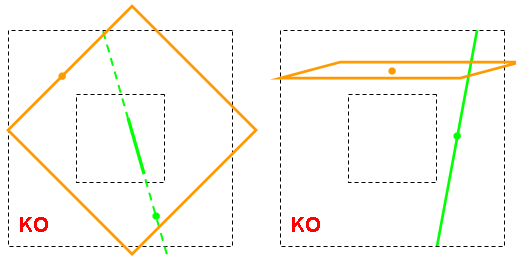
[Top]
| [1] | The Objects of CATIA Geometric Modeler |
| [Top] | |
| Version: 1 [July 2005] | Document created |
| [Top] | |
Copyright © 2005, Dassault Systèmes. All rights reserved.